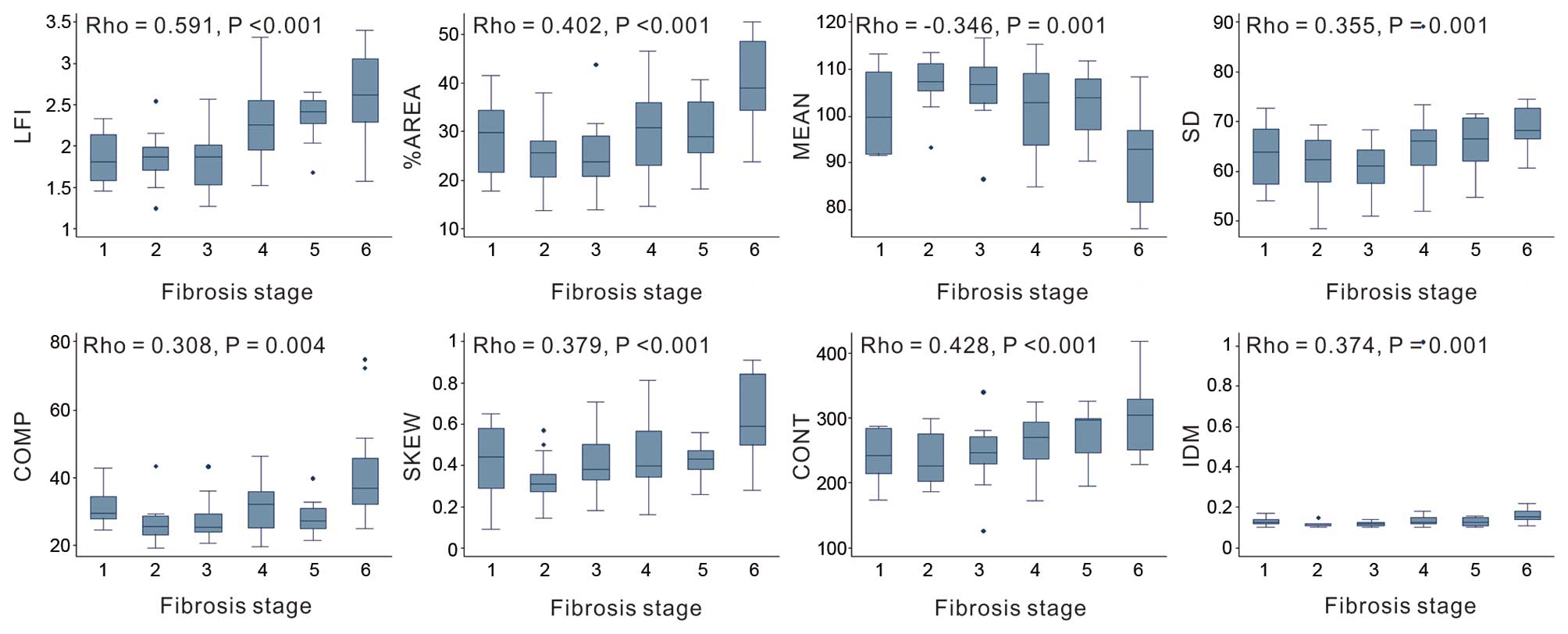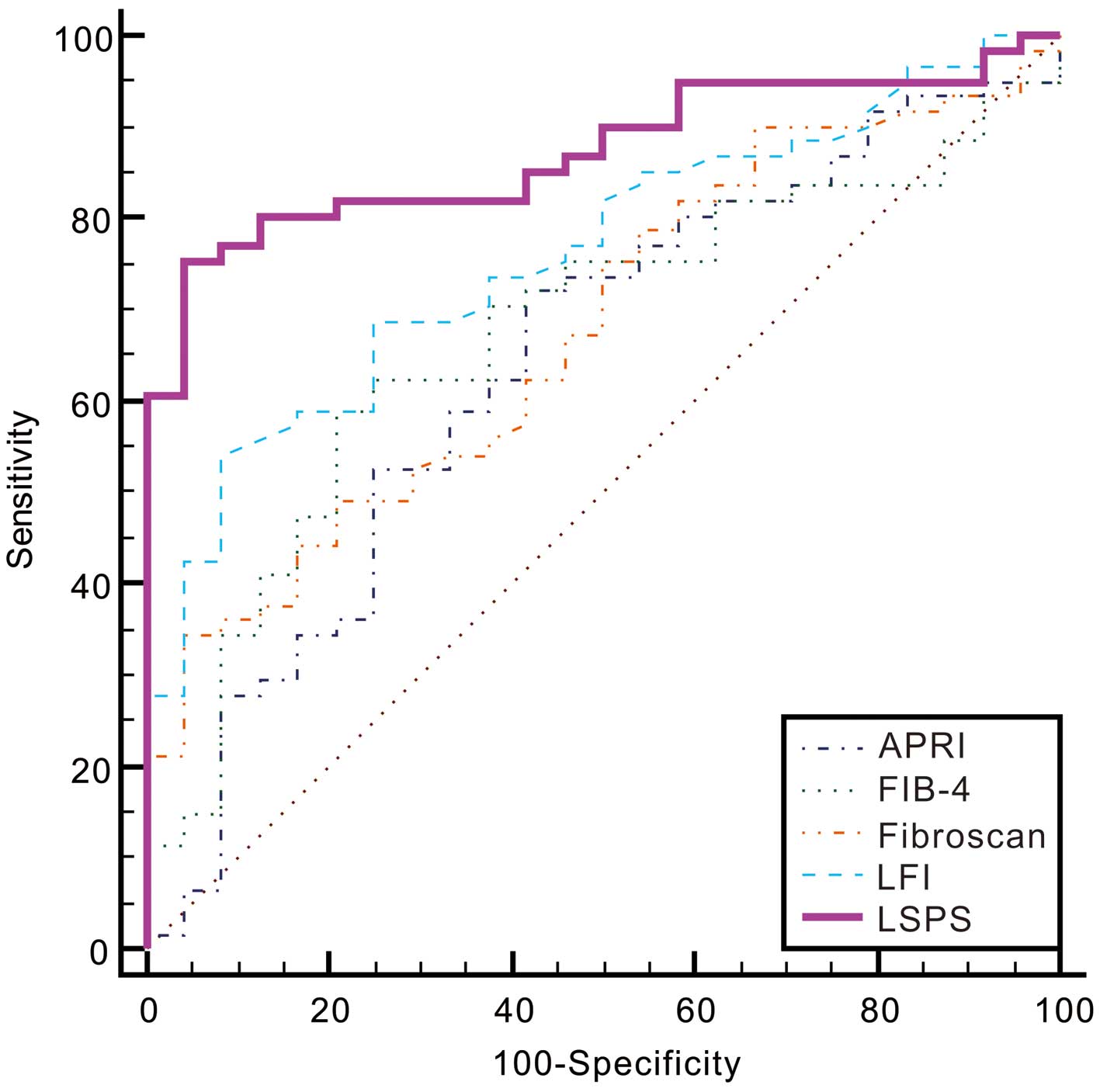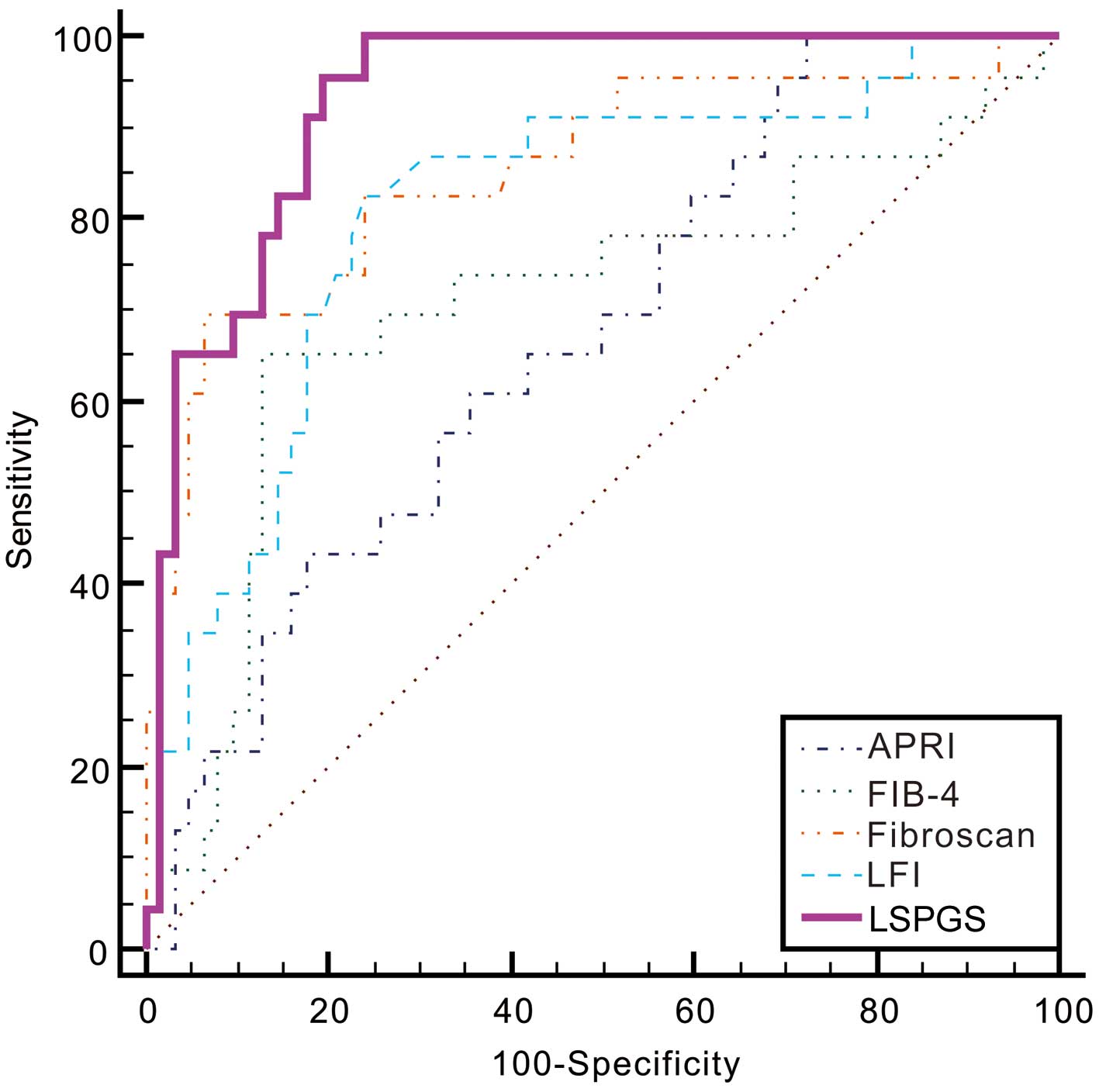|
1
|
Yu R, Fan R and Hou J: Chronic hepatitis B
virus infection: Epidemiology, prevention, and treatment in China.
Front Med. 8:135–144. 2014. View Article : Google Scholar : PubMed/NCBI
|
|
2
|
Liaw YF: Reversal of cirrhosis: An
achievable goal of hepatitis B antiviral therapy. J Hepatol.
59:880–881. 2013. View Article : Google Scholar : PubMed/NCBI
|
|
3
|
Guido M, Mangia A and Faa G; Gruppo
Italiano Patologi Apparato Digerente (GIPAD); Società Italiana di
Anatomia Patologica e Citopatologia Diagnostica/International
Academy of Pathology Italian division (SIAPEC/IAP): Chronic viral
hepatitis: The histology report. Dig Liver Dis. 43(Suppl 4):
S331–S343. 2011. View Article : Google Scholar : PubMed/NCBI
|
|
4
|
Castera L: Noninvasive methods to assess
liver disease in patients with hepatitis B or C. Gastroenterology.
142:1293–1302.e4. 2012. View Article : Google Scholar : PubMed/NCBI
|
|
5
|
Gaia S, Campion D, Evangelista A, Spandre
M, Cosso L, Brunello F, Ciccone G, Bugianesi E and Rizzetto M:
Non-invasive score system for fibrosis in chronic hepatitis:
Proposal for a model based on biochemical, FibroScan and ultrasound
data. Liver Int. 35:2027–2035. 2015. View Article : Google Scholar
|
|
6
|
Hu X, Xu X, Zhang Q, Zhang H, Liu J and
Qian L: Indirect prediction of liver fibrosis by quantitative
measurement of spleen stiffness using the FibroScan system. J
Ultrasound Med. 33:73–81. 2014. View Article : Google Scholar
|
|
7
|
Kim SU, Lee JH, Kim DY, Ahn SH, Jung KS,
Choi EH, Park YN, Han KH, Chon CY and Park JY: Prediction of
liver-related events using fibroscan in chronic hepatitis B
patients showing advanced liver fibrosis. PLoS One. 7:e366762012.
View Article : Google Scholar : PubMed/NCBI
|
|
8
|
Bamber J, Cosgrove D, Dietrich CF,
Fromageau J, Bojunga J, Calliada F, Cantisani V, Correas JM,
D'Onofrio M, Drakonaki EE, et al: EFSUMB guidelines and
recommendations on the clinical use of ultrasound elastography.
Part 1: Basic principles and technology. Ultraschall Med.
34:169–184. 2013. View Article : Google Scholar : PubMed/NCBI
|
|
9
|
Cosgrove D, Piscaglia F, Bamber J, Bojunga
J, Correas JM, Gilja OH, Klauser AS, Sporea I, Calliada F,
Cantisani V, et al: EFSUMB guidelines and recommendations on the
clinical use of ultrasound elastography. Part 2: Clinical
applications. Ultraschall Med. 34:238–253. 2013. View Article : Google Scholar : PubMed/NCBI
|
|
10
|
Hu Q, Zhu SY, Kang LK, Wang XY, Lun HM and
Xu CM: Non-invasive assessment of liver fibrosis using real-time
tissue elastography in patients with chronic hepatitis B. Clin
Radiol. 69:194–199. 2014. View Article : Google Scholar
|
|
11
|
Kobayashi K, Nakao H, Nishiyama T, Lin Y,
Kikuchi S, Kobayashi Y, Yamamoto T, Ishii N, Ohashi T, Satoh K, et
al: Diagnostic accuracy of real-time tissue elastography for the
staging of liver fibrosis: A meta-analysis. Eur Radiol. 25:230–238.
2015. View Article : Google Scholar
|
|
12
|
Yada N, Kudo M, Morikawa H, Fujimoto K,
Kato M and Kawada N: Assessment of liver fibrosis with real-time
tissue elastography in chronic viral hepatitis. Oncology. 84(Suppl
1): S13–S20. 2013. View Article : Google Scholar
|
|
13
|
Fujimoto K, Kato M, Kudo M, Yada N, Shiina
T, Ueshima K, Yamada Y, Ishida T, Azuma M, Yamasaki M, et al: Novel
image analysis method using ultrasound elastography for noninvasive
evaluation of hepatic fibrosis in patients with chronic hepatitis
C. Oncology. 84(Suppl 1): S3–S12. 2013. View Article : Google Scholar
|
|
14
|
Shiraishi A, Hiraoka A, Aibiki T, Okudaira
T, Kawamura T, Imai Y, Tatsukawa H, Yamago H, Nakahara H, Shimizu
Y, et al: Real-time tissue elastography: Non-invasive evaluation of
liver fibrosis in chronic liver disease due to HCV.
Hepatogastroenterology. 61:2084–2090. 2014.
|
|
15
|
Yada N, Kudo M, Kawada N, Sato S, Osaki Y,
Ishikawa A, Miyoshi H, Sakamoto M, Kage M, Nakashima O and Tonomura
A: Noninvasive diagnosis of liver fibrosis: Utility of data mining
of both ultrasound elastography and serological findings to
construct a decision tree. Oncology. 87(Suppl 1): S63–S72. 2014.
View Article : Google Scholar
|
|
16
|
Xiao G, Yang J and Yan L: Comparison of
diagnostic accuracy of aspartate aminotransferase to platelet ratio
index and fibrosis-4 index for detecting liver fibrosis in adult
patients with chronic hepatitis B virus infection: A systemic
review and meta-analysis. Hepatology. 61:292–302. 2015. View Article : Google Scholar
|
|
17
|
Wu T, Ren J, Cong SZ, Meng FK, Yang H, Luo
Y, Lin HJ, Sun Y, Wang XY, Pei SF, et al: Accuracy of real-time
tissue elastography for the evaluation of hepatic fibrosis in
patients with chronic hepatitis B: A prospective multicenter study.
Dig Dis. 32:791–799. 2014. View Article : Google Scholar : PubMed/NCBI
|
|
18
|
Mathurin P and Bataller R: Trends in the
management and burden of alcoholic liver disease. J Hepatol. 62(1
Suppl): S38–S46. 2015. View Article : Google Scholar : PubMed/NCBI
|
|
19
|
Liaw YF, Leung N, Kao JH, Piratvisuth T,
Gane E, Han KH, Guan R, Lau GK and Locarnini S; Chronic Hepatitis B
Guideline Working Party of the Asian-Pacific Association for the
Study of the Liver: Asian-Pacific consensus statement on the
management of chronic hepatitis B: A 2008 update. Hepatol Int.
2:263–283. 2008. View Article : Google Scholar
|
|
20
|
Huang ZL, Chen XP, Zhao QY, Zheng YB, Peng
L, Gao ZL and Zhao ZX: An albumin, collagen IV, and longitudinal
diameter of spleen scoring system superior to APRI for assessing
liver fibrosis in chronic hepatitis B patients. Int J Infect Dis.
31:18–22. 2015. View Article : Google Scholar
|
|
21
|
Liu CH, Hsu SJ, Liang CC, Tsai FC, Lin JW,
Liu CJ, Yang PM, Lai MY, Chen PJ, Chen JH, et al: Esophageal
varices: Noninvasive diagnosis with duplex Doppler US in patients
with compensated cirrhosis. Radiology. 248:132–139. 2008.
View Article : Google Scholar : PubMed/NCBI
|
|
22
|
Scott DR and Levy MT: Liver transient
elastography (Fibroscan): A place in the management algorithms of
chronic viral hepatitis. Antivir Ther. 15:1–11. 2010. View Article : Google Scholar : PubMed/NCBI
|
|
23
|
Tatsumi C, Kudo M, Ueshima K, Kitai S,
Ishikawa E, Yada N, Hagiwara S, Inoue T, Minami Y, Chung H, et al:
Non-invasive evaluation of hepatic fibrosis for type C chronic
hepatitis. Intervirology. 53:76–81. 2010. View Article : Google Scholar : PubMed/NCBI
|
|
24
|
Xu S, Wang Y, Tai DC, Wang S, Cheng CL,
Peng Q, Yan J, Chen Y, Sun J, Liang X, et al: qFibrosis: A
fully-quantitative innovative method incorporating histological
features to facilitate accurate fibrosis scoring in animal model
and chronic hepatitis B patients. J Hepatol. 61:260–269. 2014.
View Article : Google Scholar : PubMed/NCBI
|
|
25
|
Ishak K, Baptista A, Bianchi L, Callea F,
De Groote J, Gudat F, Denk H, Desmet V, Korb G, MacSween RN, et al:
Histological grading and staging of chronic hepatitis. J Hepatol.
22:696–699. 1995. View Article : Google Scholar : PubMed/NCBI
|
|
26
|
Parker CB and DeLong ER: ROC methodology
within a monitoring framework. Stat Med. 22:3473–3488. 2003.
View Article : Google Scholar : PubMed/NCBI
|
|
27
|
Bedossa P, Dargère D and Paradis V:
Sampling variability of liver fibrosis in chronic hepatitis C.
Hepatology. 38:1449–1457. 2003. View Article : Google Scholar : PubMed/NCBI
|
|
28
|
Goldin RD, Goldin JG, Burt AD, Dhillon PA,
Hubscher S, Wyatt J and Patel N: Intra-observer and inter-observer
variation in the histopathological assessment of chronic viral
hepatitis. J Hepatol. 25:649–654. 1996. View Article : Google Scholar : PubMed/NCBI
|
|
29
|
Xu XY, Kong H, Song RX, Zhai YH, Wu XF, Ai
WS and Liu HB: The effectiveness of noninvasive biomarkers to
predict hepatitis B-related significant fibrosis and cirrhosis: A
systematic review and meta-analysis of diagnostic test accuracy.
PLoS One. 9:e1001822014. View Article : Google Scholar : PubMed/NCBI
|
|
30
|
Ozel BD, Poyrazoğlu OK, Karaman A, Karaman
H, Altinkaya E, Sevinç E and Zararsiz G: The PAPAS index: A novel
index for the prediction of hepatitis C-related fibrosis. Eur J
Gastroenterol Hepatol. 27:895–900. 2015. View Article : Google Scholar : PubMed/NCBI
|
|
31
|
Chon YE, Choi EH, Song KJ, Park JY, Kim do
Y, Han KH, Chon CY, Ahn SH and Kim SU: Performance of transient
elastography for the staging of liver fibrosis in patients with
chronic hepatitis B: A meta-analysis. PLoS One. 7:e449302012.
View Article : Google Scholar : PubMed/NCBI
|
|
32
|
Kim SU, Seo YS, Cheong JY, Kim MY, Kim JK,
Um SH, Cho SW, Paik SK, Lee KS, Han KH and Ahn SH: Factors that
affect the diagnostic accuracy of liver fibrosis measurement by
Fibroscan in patients with chronic hepatitis B. Aliment Pharmacol
Ther. 32:498–505. 2010. View Article : Google Scholar : PubMed/NCBI
|
|
33
|
Sheth SG, Flamm SL, Gordon FD and Chopra
S: AST/ALT ratio predicts cirrhosis in patients with chronic
hepatitis C virus infection. Am J Gastroenterol. 93:44–48. 1998.
View Article : Google Scholar : PubMed/NCBI
|
|
34
|
Murali AR, Attar BM, Katz A, Kotwal V and
Clarke PM: Utility of platelet count for predicting cirrhosis in
alcoholic liver disease: Model for identifying cirrhosis in a US
population. J Gen Intern Med. 30:1112–1117. 2015. View Article : Google Scholar : PubMed/NCBI
|
|
35
|
Imbert-Bismut F, Ratziu V, Pieroni L,
Charlotte F, Benhamou Y and Poynard T; MULTIVIRC Group: Biochemical
markers of liver fibrosis in patients with hepatitis C virus
infection: A prospective study. Lancet. 357:1069–1075. 2001.
View Article : Google Scholar : PubMed/NCBI
|
|
36
|
Lens S, Torres F, Puigvehi M, Mariño Z,
Londoño MC, Martinez SM, García-Juárez I, García-Criado Á, Gilabert
R, Bru C, et al: Predicting the development of liver cirrhosis by
simple modelling in patients with chronic hepatitis C. Aliment
Pharmacol Ther. 43:364–374. 2016. View Article : Google Scholar
|
|
37
|
Marin-Serrano E, Rodriguez-Ramos C,
Diaz-Garcia F, Martin-Herrera L, Fernández-Gutiérrez-Del-Alamo C
and Girón-González JA: Hepatocyte growth factor and chronic
hepatitis C. Rev Esp Enferm Dig. 102:365–371. 2010. View Article : Google Scholar : PubMed/NCBI
|
|
38
|
Bolognesi M, Merkel C, Sacerdoti D, Nava V
and Gatta A: Role of spleen enlargement in cirrhosis with portal
hypertension. Dig Liver Dis. 34:144–150. 2002. View Article : Google Scholar : PubMed/NCBI
|
|
39
|
Zeng X, Xu C, He D, Li M, Zhang H, Wu Q,
Xiang D and Wang Y: Performance of several simple, noninvasive
models for assessing significant liver fibrosis in patients with
chronic hepatitis B. Croat Med J. 56:272–279. 2015. View Article : Google Scholar : PubMed/NCBI
|
|
40
|
Ucar F, Sezer S, Ginis Z, Ozturk G,
Albayrak A, Basar O, Ekiz F, Coban S, Yuksel O, Armutcu F and Akbal
E: APRI, the FIB-4 score, and Forn's index have noninvasive
diagnostic value for liver fibrosis in patients with chronic
hepatitis B. Eur J Gastroenterol Hepatol. 25:1076–1081. 2013.
View Article : Google Scholar : PubMed/NCBI
|
|
41
|
Li Y, Chen Y and Zhao Y: The diagnostic
value of the FIB-4 index for staging hepatitis B-related fibrosis:
A meta-analysis. PLoS One. 9:e1057282014. View Article : Google Scholar : PubMed/NCBI
|












